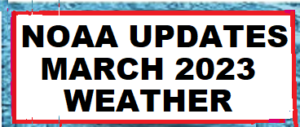NOAA Updates It’s March 2023 Outlook on February 28, 2023
At the end of every month, NOAA updates its Outlook for the following month which in this case is March of 2023. We are reporting on that tonight.
There have been some significant changes in the Outlook for March and these are addressed in the NOAA Discussion so it is well worth reading. We highlighted some of the important changes within the NOAA Discussion. We also provided the prior Mid-Month Outlook for March for comparison. From the NOAA Discussion:
- “the updated temperature outlook has increased forecast coverage and probabilities for below-normal temperatures for the western CONUS and for the northern Plains, Midwest, Great Lakes, mid-Atlantic and Northeast.”
- “Stronger support for favored below-normal monthly mean temperatures for more of the central and eastern CONUS resulted in a reduction in the depicted area for favored above-normal temperatures which are now forecast from Texas eastward to the lower Atlantic seaboard.”
- “a somewhat southward displaced overall anomalous precipitation forecast pattern.”
The article includes the Drought Outlook for March. We have also included the current fire incidents (not many) and four months of Wildland Fire Potential Outlooks and also a map showing the year-to-date snowpack in the West. We also provide the Week 2/3 Tropical Outlook for the World.

